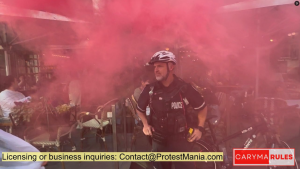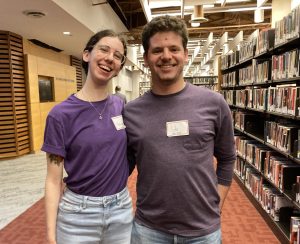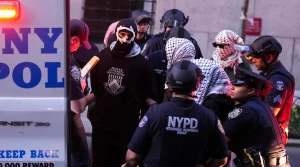A raucous anti-Israel protest outside a synagogue in Thornhill, Ont., which was hosting an Israeli real estate event, is being called a failed test of a bylaw that was intended to keep demonstrations at a distance from religious institutions.
The protest in front of the Beth Avraham Yoseph of Toronto synagogue (BAYT) on Dec. 9 saw chaotic swarms of counter-protesters and police officers following demonstrators along residential sidewalks while the event took place inside the synagogue. York Regional Police (YRP) and city staff had closed a number of streets in advance of the event.
In June, Vaughan city council passed a bylaw preventing “nuisance demonstrations” within 100 metres of synagogues and other vulnerable infrastructure, in direct response to previous demonstrations over Israeli real estate events at synagogues.
Yet on Monday night, demonstrators assembled across from the synagogue, on the south side of Clark Avenue, well within 100 meters of BAYT, for the majority of the hours-long event.
Vaughan’s Protecting Vulnerable Social Infrastructure bylaw prohibits “anyone from organizing or participating in any and all nuisance demonstrations within 100 metres of the property line” of places of worship, schools, childcare centres, hospitals and group-care facilities.
“Nuisance demonstrations,” according to the bylaw, “includes one or more people publicly protesting or expressing views on an issue in any manner—whether intended or not—that causes a reasonable person, on an objective standard, to be intimidated meaning that they are either concerned for their safety or security, or unable to access vulnerable social infrastructure.”
The bylaw cites examples of potentially intimidating behaviour; however, enforcement of the bylaw appears to be subject to interpretation by YRP officers and city bylaw enforcement officers onsite to determine if protests are deemed “peaceful gatherings, protests or demonstrations” as opposed to “nuisance demonstrations.”
“When deciding whether a reasonable person would be intimidated by a demonstration, enforcement staff will make a case-by-case assessment having regard to the objective facts and also what prior court decisions have said about what a ‘reasonable person’ is,” the bylaw read. “Not all instances of individuals stating they are intimidated will necessarily lead to by-law enforcement. Enforcement staff will use best efforts to enforce the by-law and minimally impair individuals’ Charter rights.”
At one point, police—responding to complaints reportedly coming from the demonstrators, whose loud noises such as drums and PA systems police had prohibited—investigated noise from a nearby home blasting Israeli music, and residents were asked to lower the volume while protesters walked nearby streets.
While hectic, there were no reports of property damages or physical assaults. Similar protests at Israeli real estate expos in March resulted in arrests and physical altercations.
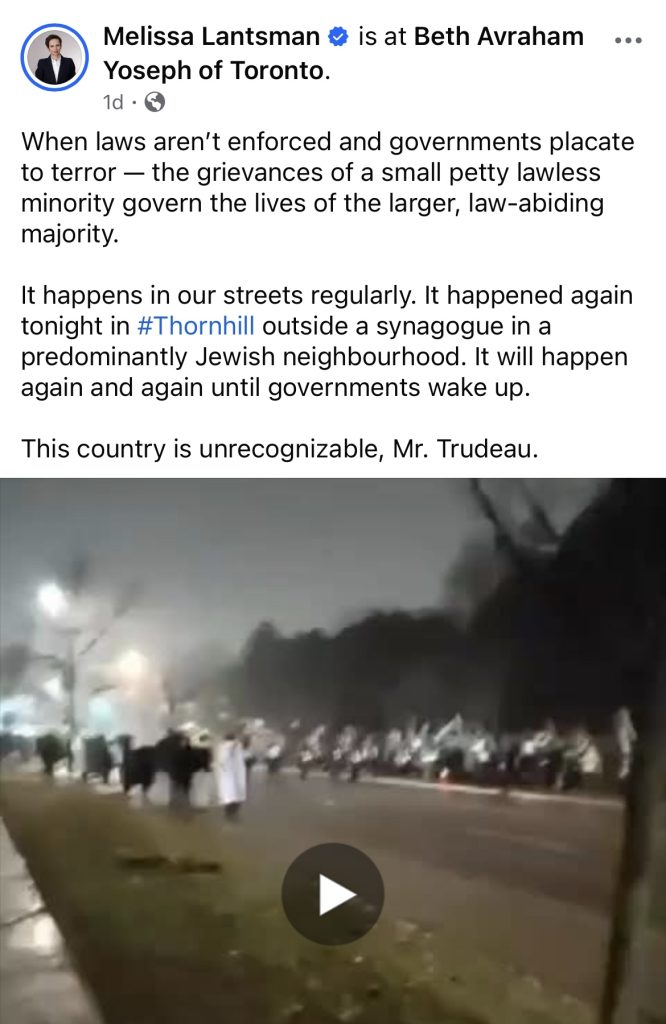
Rabbi Daniel Korobkin of BAYT said he had been in close contact with Vaughan Mayor Steven Del Duca before, during and after the real estate event and protest on Dec. 9. He said that while Del Duca and other officials, including MPP Laura Smith, are “trying their best to help the Jewish community,” he thinks there’s a disconnect between what the bylaw was supposed to allow police to do and what took place.
“We don’t know where this directive is coming from, where the [police] have interpreted the bylaw in as liberal a way as possible,” Rabbi Korobkin told The CJN in a phone interview. He said he’d met with YRP officers ahead of the event and asked them to specifically uphold trespassing laws and a noise bylaw that he says police did not enforce during the last protests.
“We asked them to uphold the new bylaw, which allegedly prohibits any kind of intimidating protest, or nuisance protest, within 100 metres of the house of worship. We had every reason to believe that the police would prevent protesters from being within 100 metres of our property. But that did not transpire,” he said.
“What instead transpired is that the police told us that anyone who wants to stand within 100 metres is welcome to do so provided that they are not threatening, that they are not chanting hate speech, that they are not saying something that’s inciteful. And so, the police allowed the protesters to be on the other side of Clark Avenue from the synagogue.”
He notes “a very sincere effort to uphold the bylaw on noise” by officers who would shut down loud sounds “any time someone tried a drum or a loudspeaker.”
“We’re grateful for that. But when it came to the shouting of epithets, like to ‘Go back to Europe’ or ‘You’re guilty of genocide,’ which was one of the signs that was held up, the police did not uphold their side of the bargain.”
He says there were different police unit commanders on each side of the road, and that “the police presence that was on our side basically said, ‘I’m not in charge of their side.’”
“The fact is that they were only doing some of their job, they weren’t doing the entire job,” said Rabbi Korobkin.
“There were groups of protesters who were walking private streets… making loud and boisterous comments, intimidating the neighbourhood, and—bylaw or no bylaw—that simply is their right to do so, and the culture that currently persists within the GTA is that you can say whatever you want, even if it’s inciteful, even if it’s hate speech, and no one’s going to stop you.
“While I’m not intimidated, and we’re going to continue doing business as usual, I think there is fear within the Jewish community, and concern that people feel that our authorities don’t really care about the Jewish community.”
The test of the Vaughan bylaw, according to Rabbi Korobkin, shows the need to “go back to the drawing board and start all over again.”
“There needs to be a different strategy, where our society has a zero-tolerance policy for hatred on either side.
“There is fear in the community. People just want a sense of security. We’re right now on a powder keg,” he said, referring to the synagogue in Melbourne, Australia, set on fire the previous Shabbat, while people were inside.
“We’ve experienced Jewish schools being shot at and vandalized. People… want to know that the police care as much about the Jewish community as they do about these violent protesters.
“To give you an illustration… [as the night was] winding down, the police went first to the Jews on the side of the synagogue telling them to disperse, before they told the protesters to disperse, which to me is just a further indication that there’s a lopsided sense of priority here.”
He says the real estate event inside the synagogue included 22 realtors who came from Israel, and that the synagogue discouraged the inclusion of properties for sale in the West Bank. The CJN did not independently verify details of properties for sale at the event.
“We made it clear to them that we did not want them to showcase any properties on the other side of the Green Line, even though, personally, I have no issue with that,” he says. “We did not want to deliberately be a provocation.”
“In retrospect, that was probably naive, because the opposition, the people who came out and were told to come out in protest, are people who sincerely believe that any square inch that exists in the country called Israel today cannot be legitimately purchased by Jews.”
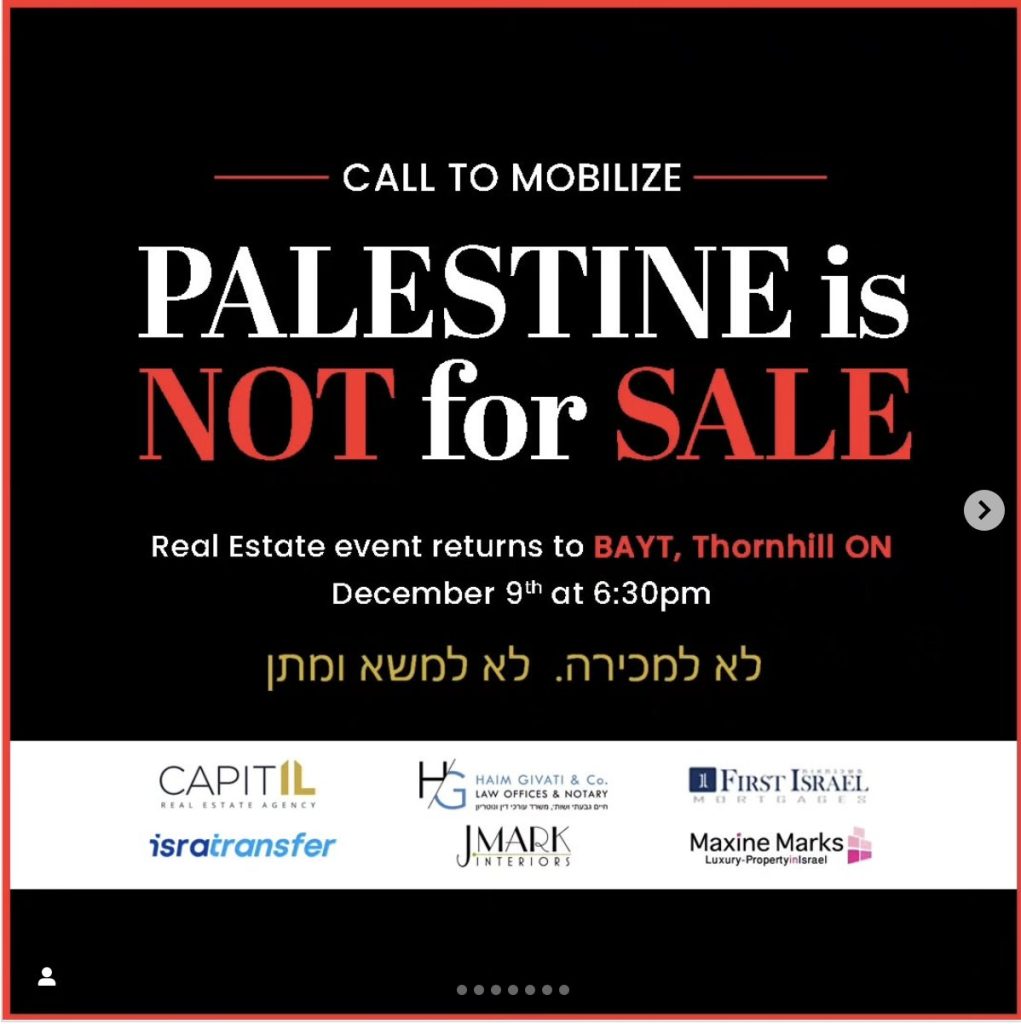
Mayor Del Duca, who played a substantial role in creating and passing the bylaw, acknowledges that the Dec. 9 protest shows there’s plenty to learn from how recent events played out.
“People are, it’s a range of confused and angry, concerned, disappointed… I think mostly looking for answers to the legitimate questions they have about what took place on Monday and the difference between their understanding of the bylaw and then what they saw in real time, or what they’ve heard about in the aftermath,” he said.
“There [are] a lot of lessons I think we do have to learn from Monday night and I am going to work very, very hard along with city staff and YRP and others to make sure that we do learn those lessons so that we can do even better going forward, should the need ever arise,” he said.
Del Duca told The CJN in a phone interview on Dec. 11 that the city and YRP need to work together to “go through real-time potential scenarios” to learn and improve on the response to Monday’s demonstration.
He says in speaking to residents Monday night and since, he’s had to explain what “nuisance” demonstrations mean from a legal standpoint.
“I totally understand where [residents who are upset are] coming from. They think of the concept of a nuisance in somewhat of a conventional way. But there’s also a legal definition of what that’s supposed to mean, and where’s the line between what was and what wasn’t,” he said. “None of what I’m saying is meant to diminish the fears, the concerns, the anger that our residents are [feeling].
“I think the responsibility that I have and we have is, we saw in real time how using the bylaw is a tool played out, or maybe not using it as a tool played out,” he said.
Del Duca says the work ahead involves developing policies and protocols for city and police, including addressing the distinctions between types of demonstrations.
“The notion of the 100 metres is something that’s really important. Obviously, it’s foundational to the bylaw itself, and I know that’s captured a lot of attention through the months since we introduced and passed the bylaw.
“Where it becomes less clear, and we said this throughout this entire process… is that the bylaw doesn’t impact what is peaceful protest,” he said.
“Regardless of the issue or the cause… if a person is standing within 100 metres of a place of worship or a school or a daycare, and they’re engaging in what is legitimately peaceful protest, you know, that that’s not something that would trigger the bylaw in terms of making them move further away.”
He says the key question to determine will be whether a peaceful protest turns to a nuisance demonstration.
“I think we have more work to do in terms of playing out all of those scenarios and then having a strong sense of how to respond in the moment.”
He says that while much work was done in developing the bylaw’s policies or protocols “so that if we ever ended up in a situation like this, that would be a clear understanding of how we would deal with it,” this was also the first time the bylaw was tested.
Vaughan was also the first municipality to pass such a bylaw, he said.
Toronto considered a similar “protest bubble zone” bylaw, but councillors voted against it, instead allowing the City and police to develop plans for managing protests and rapid responses to hateful graffiti.
Del Duca acknowledges there aren’t always immediate, clear distinctions, for example, in the middle of a demonstration.
“It does come down to interpretation. But I’m convinced that with enough collaboration and enough scenario planning that we should be able to come to a good spot. It would have been ideal if that had been in place before Monday, I think some of it was, but there’s always a difference between the theoretical preparedness and the practical realities on the ground in a tense situation like we were dealing with on Monday night,” he said.
He says he understands how community members are feeling, and confirms he’s been speaking with Rabbi Korobkin regularly.
“I would just say to the community, I’m aware of the work that still needs to be done and I am committed to making sure that we do it and that I think will position all of us even more strongly to be even better prepared in the future.”
Gila Martow, the Vaughan Ward 5 councillor who represents BAYT’s district, echoed the call to answer questions about the disconnect between expectations and outcomes on Dec. 9, and address community concerns around protest scenarios outside synagogues in the area.
“I have a lot of questions that I’m trying to get answers to, including why police would tell my residents to turn down Israeli music in their backyards, supposedly at the request of the uninvited visitors,” wrote Martow in a brief email statement.
“While I respect the efforts of York Regional Police to keep everyone safe, we need to come up with strategies to emotionally support the Jewish community in the face of unrelenting hate.”
York Regional Police stated in an email to The CJN that the investigation into the Dec. 9 protest was ongoing. Police, however, are unable to make arrests for bylaw infractions.
“In the coming weeks, YRP will be meeting with community partners, including faith leaders and municipal government, to review both this demonstration and discuss how future demonstrations are managed within York Region.”
Author

Jonathan Rothman is a reporter for The CJN based in Toronto, covering municipal politics, the arts, and police, security and court stories impacting the Jewish community locally and around Canada. He has worked in online newsrooms at the CBC and Yahoo Canada, and on creative digital teams at the CBC, and The Walrus, where he produced a seven-hour live webcast event. Jonathan has written for Spacing, NOW Toronto (the former weekly), Exclaim!, and The Globe and Mail, and has reported on arts & culture and produced audio stories for CBC Radio.
View all posts




